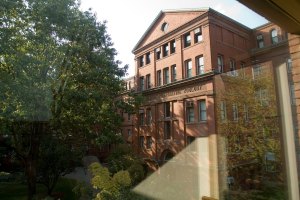This month in Harvard history
May 1, 1775 — By order of the Committee of Safety, the College closes early. The Provincial Congress soon commandeers Harvard’s buildings and orders the library and scientific instruments to Andover for safekeeping. It takes several months for the College to find a suitable place (Concord) to reconvene. Four Harvard buildings soon quarter local troops: Massachusetts and Hollis Halls (640 each), Stoughton College (240; dismantled in 1781 and replaced in 1805 by the current hall of the same name), and Holden Chapel (160). Half a ton of lead from the Harvard Hall roof is also recycled into bullets that help drive the British from Boston.
May 1879 — The committee on women’s education (chaired by Elizabeth Cary Agassiz) announces its first course offerings (51) in the following subjects: English, French, German, Greek, Italian, Latin, Spanish, history, mathematics, music, natural history, philosophy, physics, and political economy.
If required, instruction could also be given in chemistry (pending available laboratory space), Sanskrit, comparative philology, and Romance philology.
Full tuition costs $200; a single course is $75. With this fee structure and $16,000 in contributions, the committee expects the educational experiment to survive four years.
May 23, 1910 — The Harvard Corporation formally adopts crimson as Harvard’s official color, based on the tint of several silk scarves used by Harvard rowers in the 1858 Boston City Regatta and preserved in the University Archives.
May 1, 1918 — In the wake of World War I, University enrollment has dropped by some 80 percent.
May 26, 1921 — In the Faculty Room of University Hall, the Harvard Memorial Society presents the University with a portrait of Charles Eliot Norton, the late History of Art Professor Emeritus. Professor George Herbert Palmer speaks.
May 1931 — The George Edward Woodberry Poetry Room—a gift of Harry Harkness Flagler—opens on the third floor of Widener Library. (The Woodberry Poetry Room is now in Lamont Library.)
May 14, 1942 — Peruvian President Manuel Prado visits Harvard during a “Good Neighbor” tour of the eastern U.S. (His son Manuel I. Prado is also a senior at the time.) During a special welcoming ceremony in the Faculty Room of University Hall, Prado brings greetings from Lima’s University of San Marcos (est. 1551), where before his election he had taught calculus. From the steps of Widener, 1,000 students cheer him.
— From the Harvard Historical Calendar, a database compiled by Marvin Hightower




